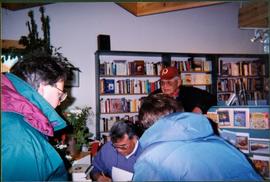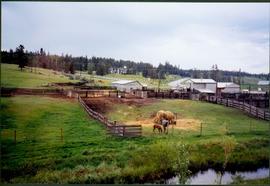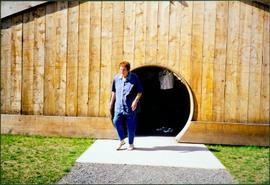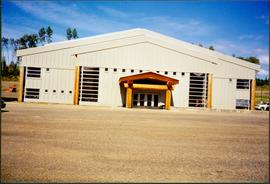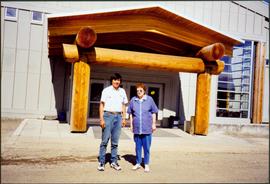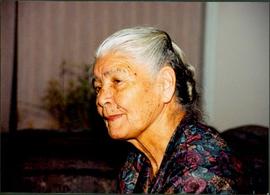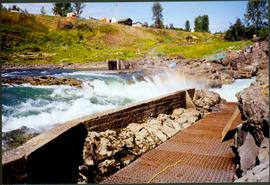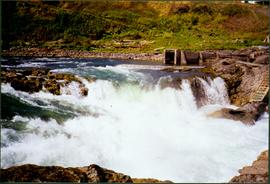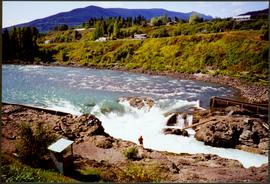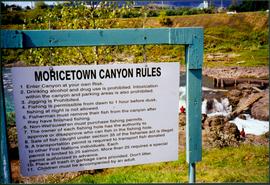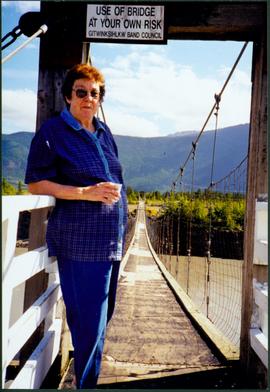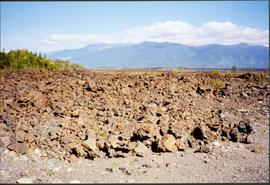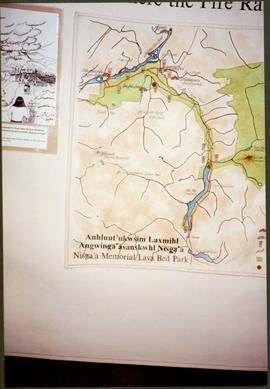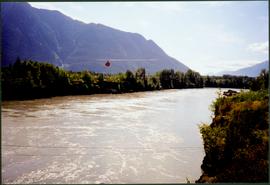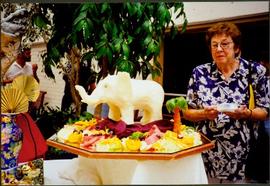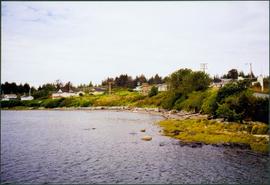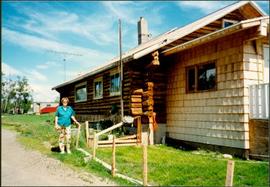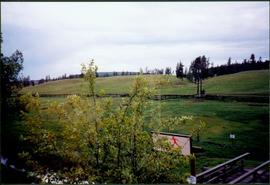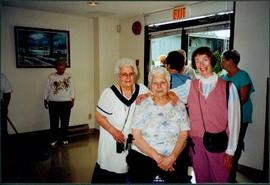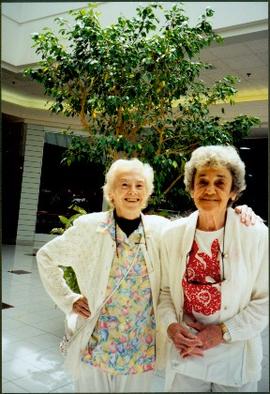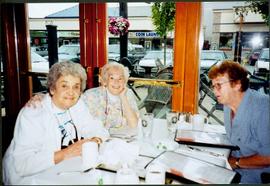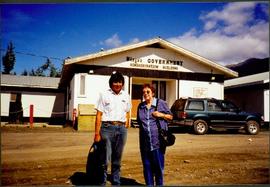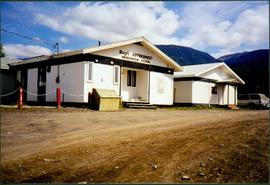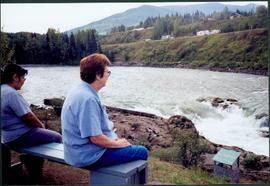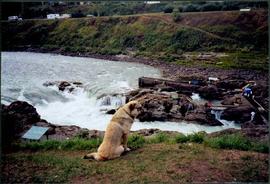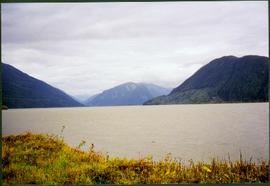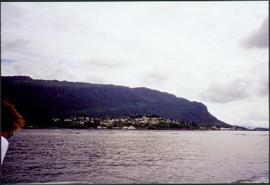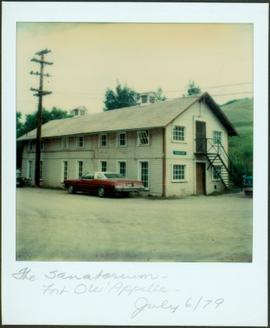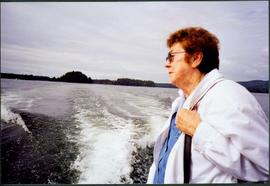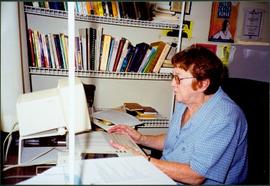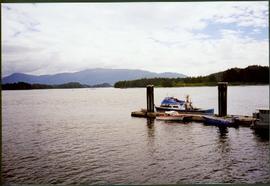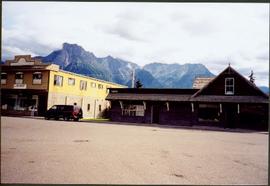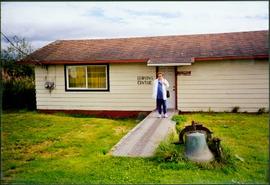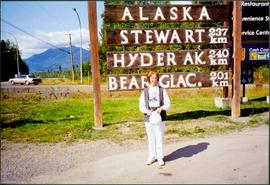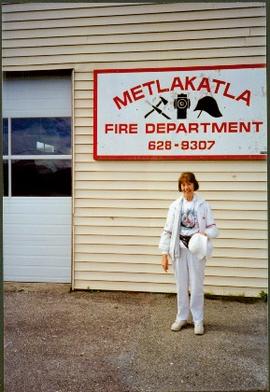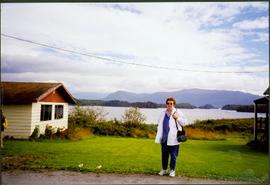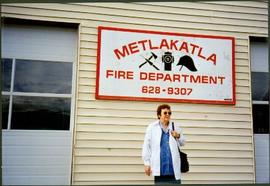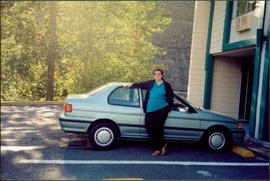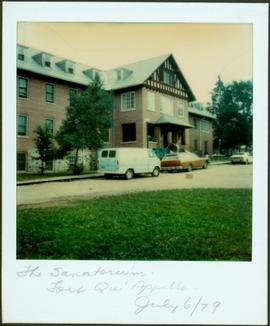Photograph depicts three unidentified individuals gathered around Justa Monk as he signs a copy of 'Justa: a First Nations Leader'. Plants and bookshelves in background.
Photograph depicts two horses in one of many fenced areas, buildings and machinery in background. Highway, house, and forest also visible in distance.
Photograph depicts Moran walking away from round entrance to long house, unidentified individual visible inside.
Photograph depicts unidentified building with large wood beams in entryway.
Photograph depicts Moran standing with unknown man in front of building with large wood beams in entryway (see also item 2008.3.1.22.25 for image featuring Moran with this young man).
Close view of Mary John. Plant, couch, and window in background.
Photograph depicts fishing territory at waterfall rapids in Bulkley River, B.C. Highway and buildings on opposite shore in background.
Photograph depicts white rapids at bottom of waterfall in Bulkley River, B.C. Fishing territory visible on far right; hill on opposite shore in background.
Photograph depicts an unidentified individual standing on cliff above waterfall at Bulkley River, B.C. Fishing territory visible below; highway, buildings, and hills visible in background.
Photograph depicts sign in foreground outlining rules and restrictions for behaviour at Moricetown Canyon. Traditional fishing territory visible behind sign at waterfall in the Bulkley River, B.C. Highway and buildings can be seen in background.
Photograph depicts Moran standing in front of bridge featuring a sign reading "USE OF BRIDGE AT YOUR OWN RISK / GITWINKSIHLKW BAND COUNCIL". River below, hills on opposite shore in background.
Photograph depicts what appears to be a lava bed, see item 2008.3.1.22.33.
Photograph depicts colour map displayed in unknown area, second poster semi-visible on left. See item 2008.3.1.22.34 for image believed to depict lava bed.
Photograph depicts wide river with forest shores on either side. Power lines in foreground, mountain in background.
Photograph depicts Moran standing in floral print dress, holding plate of food by fruit platter featuring a carved elephant and palm tree. Party decorations and tree can be seen in image. Building and unidentified men stand in background.
Photograph depicts water in foreground, bayside village in background.
Photograph depicts Moran standing by fence in front yard of log building with a shingled addition in foreground. Dirt road in left foreground; trees and small trailers in background.
Photograph depicts landscape scene. Tree, bridge, and sign featuring cross country skier in foreground. Fence, hills, and forest in background.
Photograph depicts three elderly women posing together for photograph. Six other women visible in building; second building can be seen through door in background.
Photograph depicts two unidentified woman standing in front of tall plant in mall. Photo believed to have been taken in Newton, B.C.
Photograph depicts Bridget Moran seated on far right, two unidentified woman on left. Vehicles and shops on street visible through windows in background.
Photograph depicts Bridget Moran standing beside unidentified man in front of white building with the sign "Nisga'a Government Administration building". Suburban parked in front of building, trees and mountains visible in background.
Photograph depicts two white buildings, one with the sign "Nisga'a Government Administration building". Road in foreground, vehicles and hills in background.
Photograph depicts Moran seated to right of woman on bench in foreground. Waterfall area at Moricetown Canyon can be seen below, behind booth labeled "MONITER BOOTH". Highway and houses visible on opposite shore in background.
Photograph depicts dog seated on grass in foreground. Unidentified individuals visible below with fishing nets in waterfall area at Moricetown Canyon.
Photograph depicts unknown lake. Grassy shore in foreground, mountains in background.
Photograph depicts unknown lake. Moran slightly visible in far left. Village can be seen on opposite shore in background.
Polaroid photograph depicting large building with the sign "TRADES SHOP". Power line and red car in foreground; hill and trees in background. Handwritten annotation on verso of photograph: "The Sanatorium. Fort Qu'Appelle - July 6/79".
Profile of Moran, wake visible in water behind her. Opposite shore in background.
Profile of Moran seated at desk with computer and piles of paper. Bookshelf in background.
Photograph depicts small boats tied at dock on lake with mountains visible in background.
Photograph depicts two large buildings across street in foreground, van visible on left.
Moran stands on sidewalk in front of building with signs reading "LEARNING CENTRE" and "ST. PAUL'S ANGLICAN CHURCH". Large iron bell sits in grass in foreground, forest in background. Photo believed to have been taken near Metlakatla Lake, B.C.
Woman stands in front of sign that reads "ALASKA / STEWART 237 km / HYDER AK. 240 km / BEAR GLAC. 201 km". Second sign in background indicates restaurant, convenience store, and service centre. Car, road, and highway can be seen in midground; mountains in background. (This woman is also featured in item 2008.3.1.22.13).
Woman stands in front of building with the sign "METLAKATLA FIRE DEPARTMENT 628-9307". Garage door visible on left.
Bridget Moran stands on road, unidentified buildings behind on either side. Lake and hills on opposite shore in background. Photo believed to be taken at Metlakatla Lake, B.C. Building on left speculated to be the St. Paul's Anglican Church Learning Centre.
Moran stands in front of building with the sign "METLAKATLA FIRE DEPARTMENT 628-9307".
Unidentified building in right foreground, forest in background.
Polaroid photograph depicting large sanatorium building. Vehicles parked on street in foreground. Handwritten annotation on verso of photograph: "The Sanatorium. Fort Qu'Appelle - July 6/79".
Audio recording consists of Bridget Moran reading chapter excerpts from her manuscript “Where Words Come Sweet” [later title of manuscript is “The Horizontal Land” which tells the tale of the Doonan family, Kate who Bridget notes “developed as a volatile woman, quick to anger, quick to tears” and her husband Charlie, a “classic quiet Irishman, in fact, rather like my own father” and their children who emigrate to the South Saskatchewan River country in September 1924. As Moran describes in a letter “in short, my novel is a rather light-hearted, hopefully, authentic look at the Saskatchewan of 1924. I was at pains to avoid the dust storm-grasshopper-flat terrain syndrome, and instead to portray the beauty of south Saskatchewan as I knew it, the wonderful blend of ethnic groups, and the richness in character of the people who have lived there.”
Audiocassette Summary
Side 1
Title: Where Words Come Sweet #1
Scope and Content: Bridget Moran reads a chapter from her story entitled “Where Words Come Sweet”. The account of the Doonan family – Charlie and Kate and their children living in the pre-Depression era on the Canadian Prairies
- Kate immerses herself in the Catholic church and its rituals
- Priest Father Boncoeur talks about generosity of those who donate to the Church
- Charlie has difficulty with the Church asking for money same as in Ireland and leaves the Church because of it;
- Conflict between Charlie & Kate regarding religion
- Prairie winter blizzard described
- End of chapter
In this audio segment Bridget reads excerpt from Chapter 17 “Hail Mary, Full of Grace” which provides the account of Father Duroc who Bridget notes in the chapter synopsis “reads out the contributors and the contributions to the church, leading to war in the Doonan household.” And of Kate’s immersion in the Catholic faith and its rituals
Side 2
Title: Where Winds Come Sweet #2
Scope & Content: Bridget Moran explains that the inspiration for the title of the manuscript, Where Winds Come Sweet was derived from a poem by Pauline Johnson – Harvest Time. Bridget proceeds to read the poem. Then Bridget describes the main characters and provides a brief synopsis: The story of an Irish Catholic family, the Doonans, who came from Ireland, originally to Ontario and then to the South Saskatchewan River country in 1924. Bridget describes the characters: Kate & Charlie Doonan, and their kids: Kevin, Patty, Mick, Bridie, Mary, and J.T. She also describes two other characters Barney and Gladys Mullins– caretakers. Bridget reads a version of the chapter “The Teacher Cometh” – noted on audio recording as Chapter 7 [in a later version of this manuscript from November 1981 this chapter is Chapter 14]. The chapter describes the coming of a school teacher Miss Doris Sutton who makes life difficult for the residents – specifically the women folk as the men in the community come to be enamoured with her. This chapter describes how Kate overcomes her dislike for the teacher Miss Sutton, how she spends a weekend with the Doonans and how they become friends.
Bridget then provides a synopsis of another chapter that she entitles on the recording as “Unholy Deadlock” In a later version of the manuscript from November 1981 this chapter is entitled “Give Us This Day” Chapter 16 and describes how Father Duroc arrives in the community in January 1925 and stays with the French Canadian family the Bouchard’s]
In the next audio segment Bridget reads excerpt from Chapter 17 “Hail Mary, Full of Grace” which provides the account of Father Duroc who Bridget notes in the chapter synopsis “reads out the contributors and the contributions to the church, leading to war in the Doonan household.”
Audio recording is of an interview that Bridget Moran conducts with a Mrs. Thompson held in Success, Saskatchewan. Mrs. Thompson talks about municipal politics in the rural town of Success, Saskatchewan when Jimmie (her husband?) was on the Council. Most of the interview relates to Mrs. Thompson’s account of the marital and domestic life Alfie (Guy?) who was another town councilor and known as a local poet.
Audiocassette Summary
Side 1
00’05” Moran asks Mrs. Thompson about the time that Jimmie (her husband?) was on the Council in Success. She recalls when her husband joined the Municipal Council and notes it was for 6-7 years; c.1960s. Bridget asks her to explain the conflict between Jimmie and Alfie (Guy?) who was also on the Success Municipal Council. Bridget refers to Alfie and how he wrote books of poetry.
04’00” Mrs. Thompson recalls Jimmie joining the Council at the time of the municipal conflict about the selling of the Sports ground and that was the time that Colleen [?] also joined the Council. Mrs. Thompson recalls getting involved in the dispute and that she encouraged the community’s women to vote on the issue of this, as well as the assessment role and taxation dispute. Notes that the town was divided “into two camps” on the issue. Also talks about the other issues that Jimmie became involved in including need to better roads in the town.
14’00” Bridget asks her about Alfie and him being a poet. Mrs. Thompson talks about Alfie returning to town after World War II and about his relationship with his first wife Lil. They eventually divorce and he remarried three more times. Most of this section is about his relationship with his second wife.
25’00” Mrs. Thompson notes that Alfie is still alive and is in his 80’s and still writes poetry. She recounts one poem he wrote entitled ‘Town of Purple Gas’ and provides an account of how he was inspired to write this – someone in town was putting an unknown substance in the gas that turned it purple… Bridget notes he was ‘quite the character.’
End of Tape
Audio recording consists of speeches and related forum questions at a public forum in Canada (Ottawa?) in post-WWII period. Speaker refers to this as the “post-McCarthy era”. The MC notes that the “CND” founders are on a speaking tour in the U.S., so it is possible this recording is a component of that tour. Speeches appear to be by Canon L. John Collins & Diana Collins who were both organizers of the Campaign for Nuclear Disarmament, an organization founded in 1958, which by 1960 was the largest mass movement in Britain. The CND organizers included philosopher Bertrand Russell, and chair of the Campaign was Canon L. John Collins and his wife Diana Collins. John & Diana Collins speak on the state of protest groups for nuclear disarmament in Britain, U.S. and Canada. The end of forum includes a political motion that the campaign for nuclear disarmament in Canada will renew itself to approach politicians to oppose arms development in Canada whether at home or abroad.
Audiocassette Summary
Side 1
00’01” -4’06” recording starts in progress with speaker possibly Cannon John Collins, chairman of the Campaign for Nuclear Disarmament
4’07-11’25” recording of woman, possibly Mrs. [John] Diana Collins of the CND; answering question from audience on how to stop nuclear war from happening
11’26-21’39” continued speeches; includes position of [Anglican?] church on nuclear disarmament and position of the Canadian Peace Institute
21’40-24’31” motion on nuclear disarmament in Canada; passed.
Audio recording consists of a CBC radio show produced in Regina, Saskatchewan broadcasting a recording of Bridget Moran’s story entitled “A Child’s Christmas in Saskatchewan”. The unidentified male radio announcer introduces Moran’s story noting it is based on her memories of Christmas as a child in rural Saskatchewan c.1920s with her family. The male announcer notes that Moran “now lives in Prince George.” The story “A Child’s Christmas in Saskatchewan” is read by broadcaster Lorna Jackson.
Audiocassette Summary
- Jackson reads the story. Bridget provides memories of receiving the Eaton’s and Simpson’s catalogues and Christmas gifts by postal mail
- Moran’s Dad delivered the mail for a few extra dollars
- Moran recalls the Christmas concert; plays; carols, and the supper dance
- Moran recalls memories of sharing Christmas dinner with the Wright’ family who were Protestant Irish farmers
Audio recording consists of an interview by Bridget Moran with James McCallum recalling his life, first in Scotland, then Montana and then as a wheat farmer in Success, Saskatchewan. McCallum (1891-1983) served on several community organizations including delegate of the Saskatchewan Wheat Pool (1938-1944) and director (1944-63). James McCallum died January 9, 1983 in Swift Current, Saskatchewan age 91.
Audiocassette Summary
- Recalls Success neighbours; Frazer [sp?] a family immigrated from Russia
- Recalls father dying at age 96
- James and his wife Sadie moved into the elder McCallum family homestead in 1962
- Recalls first date with wife in 1912 at dance; famous storm same night killed people in Regina
- Recalls playing violin at dances with Jack Pickett
- Bridget asks his memories of the Drugan family [Bridget’s; James recalls when his wife Sadie and Bridget’s mother became friends. Bridget used to stay with Sadie’s mother.
- Recalls medical facilities in early years; recalls father having blood poisoning and being attended by [the elder] Dr. Graham
End of tape
Audio recording consists of an interview by Bridget Moran with James McCallum recalling his life, first in Scotland, then Montana and then as a wheat farmer in Success, Saskatchewan. McCallum (1891-1983) served on several community organizations including delegate of the Saskatchewan Wheat Pool (1938-1944) and director (1944-63). James McCallum died January 9, 1983 in Swift Current, Saskatchewan age 91.
Audiocassette Summary
- McCallum family moved from rural Scotland to Montana and later Success, Saskatchewan. James McCallum born in Scotland – Nov 12, 1891
- James’ family left Scotland c.1899 via the ship “Caledonia” and came to Montana
- In 1904 his father decided to move the family
- Recalls living in Montana
- Recalls night at the Shaw farm in Montana with horse thieves the night his brother Allan was born
- Discusses trek to Saskatchewan arriving first in Swift Current, Saskatchewan;
- Homesteaded in Success [District], Saskatchewan
- Family’s land was Government land
- Moved from homestead to another farm
- Recalls his schooling; public school in Scotland; private school in Canada
- Talks about ranching
- Discusses income of family
- Describes types of farm machinery and combines; walking plow
- Talks about boundaries for land – no fences etc.
- Provides memories of families from the community
- Recalls memories of his mother managing household on farm
- Recalls work with threshing groups
- Recalls beginning of the Saskatchewan Wheat Pool to ensure farmers received fair payment for sale of their wheat
- Recalls attending meetings as delegate for the Saskatchewan Wheat Pool at the Canadian Federation of Agriculture; meetings held in various locales from Montreal to Vancouver
End of tape
File consists of recorded audio interviews:
- Interview: James McCallum (Tape 1), prior to 1983; possibly 1979 or 1980
- Interview: James McCallum (Tape 2), prior to 1983; possibly 1979 or 1980
- Interview: “A Child’s Christmas in Saskatchewan”, December 1980
- Interview: Recording of Campaign for Nuclear Disarmament, post February 1958; c.1958-c.1960 [?]
- Interview: Mrs. Thompson [sp?] Interview, 16 April 1981
- Interview: “Where Winds Come Sweet”, April 13, 1981
Audio recording consists of an interview conducted by Bridget Moran with Mary John.
Audiocassette Summary
00’05” Bridget is interviewing Mary John who discusses a potlatch held at Stoney Creek that Bridget attended. Bridget asks about the talking stick and she asks Mary John to explain its significance. Mary explains there had been a naming ceremony about a year ago and that a woman named Maisie had changed clans from her mother to her father’s clan. Mary notes while this is unusual, her father’s only son had died and therefore requested that the daughter changed clans. At this ‘September potlatch’ therefore this woman had to change tables at the potlatch.
04’00” Mary explains the context of the September Potlatch. She notes that Maisie had hosted this potlatch to pay back for the gifts that had been provided for her from a year ago when she received a new name. They then discuss the amount of money that the host gave to the guests and the amount of money that is normally provided – there is no particular amount ‘whatever you wish’ Mary notes she had provided Maisie with a gift last year of $100 but that Maisie gave her back $200 – that is not required – there is no required amount
07’30” Mary explains that at a potlatch you are expected to bring a case or few bags of food
08’00” Mary discusses the type of food provided at a potlatch; it is traditional food not western food; Bridget notes there was caribou provided there. Mary explains that the host of a potlatch asks people to hunt for moose and deer meat in order to prepare for the food to be served. Bridget then talks about the food that was served and Mary notes it included also fish and beaver.
11’00” Bridget asks Mary to talk about the gifts given to her daughter Flo at the potlatch in exchange for a loan she provided to another woman whose husband had died a year before. Bridget notes it was a ‘touching’ moment.
12’00” Mary talks about the Priest ‘Father Brian’ who was at the potlatch. Four clans collected money and gave it to the priest for his work [missionary work?]
15’07” Mary explains the situation of Geraldine Thomas –that at the potlatch she was not seated before; that is she was not initiated before and so she was seated at the potlatch
15’57” Tape stops momentarily
16’09” Mary continues to talk about Geraldine and the potlatch events; the significance of the tapping of the talking stick; then she was seated and guests give her gifts. Then Mary talks about Ernie and her late daughter Helen who also wanted to cross their clan but that Mary ‘did not let her go’
20’00” Mary talks about the feelings of a child who gives up their clan and that it is like ‘giving up one of your children’ as Celina noted to Bridget at the event.
21’00” Mary talks about her son Ernie who crossed over to his father’s clan and that he was gifted at the potlatch
22’00” Bridget then notes that at this potlatch that the Frog Clan became host of the Grouse clan at this potlatch. Mary explains that the clan then had debts to pay at this potlatch.
26’00” Mary talks about the death of Stoney Creek members; she is unsure when there will be another potlatch in Stoney Creek.
28’00” Bridget notes that she did not understand the ceremony as it was in Carrier language; however Bridget notes it is a pity the white world doesn’t see potlatches as they are ‘so touching’
31’00” Mary explains that each clan takes care of the deceased family members and takes care of putting up the headstone
32’00” Tape ends abruptly
Audio recording consists of an interview conducted by Bridget Moran with Mary John.
Audiocassette Summary
Scope and Content: Tape consists of a recording of Bridget interviewing Mary John primarily about her visit to the former native village site of Cheslatta
Side 1
Interview in process
00’05” Bridget interviews Mary John, Mary is referring to Madeline her niece.
1’00” Bridget asks Mary what made her decide to go to Cheslatta – to see the site where she had lived. Bridget asks if it was a ‘rediscovery’ trip. Bridget asks if this is where the village was burned out and flooded out [by Kemano development] Mary talks about her son Ernie wanting to go there and create a territorial hunting ground. She talks about going there with her niece Madeline and Alex
8’40” Mary explains how they got to Cheslatta; the travel there was by van through Francois Lake and via logging roads; it took about hour and half drive
11’00” Mary explains it was not the village that had been flooded that they went to; not the original village; she notes there was a campsite set up for them but it was cold at night. There were people there from Stellaco, about 75 total. She describes making bannock on a stick over the fire ‘the real bannock’ for the youth – like an “Indian pizza” (she laughs)
16’00” Mary continues to talk about the activities that she did at Cheslatta; show the youth how to fish, spear fish, clean fish, cut in strips and smoke the fish. There was no smokehouse but they created a lean- to and smoked the fish. Mary also notes another day Mary and Madeline took the youth to the bush and talked to them about uses of trees –
22’00”-20’25” Mary describes the steps involved with showing the youth at the Cheslatta camp how to collect spruce in order to build a smoke house for smoking the fish
29’30” Mary discusses food that she prepared for the gathering for the people
31’00” Mary talks about the group visiting the old village Cheslatta after the gathering
Mary then leaves to attend to a crying baby [a great-grand-child?]; they greet the mother
33’00” Bridget refers to a group of kids she talked to at Kamloops about their book Stoney Creek Woman. Bridget tells Mary she has letters written to Mary John by several students who had read Bridget’s book that she wants to show her
36’00” They continue to talk about the former Cheslatta village and what the former village residents want to do about the village; Mary notes there are archaeologists working there. Mary states the people have not yet received compensation for being taken off their land. Bridget notes those people loss their sense of community
38’31” Mary remarks the people at Cheslatta “have a good chief” “very humble person”
39’40” Bridget asks Mary about the Lejac pilgrimage. Mary then talks about the pilgrimage that is held at Lejac and that she had just been there ‘on Sunday night’; she notes it is arranged by Celina; she notes there were Tache people there. Bridget asks if there are children buried at Lejac and Mary notes there are children and students buried there – about 15 to 20 buried there.
43’00” They briefly discuss if this was a rediscovery for the Cheslatta people at the event. Mary agrees; she notes she stayed there for 10 days; Bridget remarks it was similar to Mary’s former camp of what she had experienced at Wedgewood. They talk about Mary’s son Ernie and that he has in Bridget’s view ‘leadership qualities”
45’30” Bridget asks about getting a bannock recipe for a Senior’s cookbook. Mary begins to tell the recipe
Side 2
47’40” Mary continues to show Bridget how to make bannock
50’00” Mary briefly refers to the event at Cheslatta again
End of tape
Audio recording consists of an interview conducted by Bridget Moran with Mary John.
Audiocassette Summary
Context: Tape recording is an interview between Bridget and Mary John in which Bridget initially asks Mary John about events after the inquest into Coreen Thomas’s death. Bridget notes also that she wants to provide an update on Mary John’s life 10 years after the inquest.
Side 1
00’05” Bridget asks Mary John about her role in the Coreen Thomas inquest. Mary thinks that she discovered Coreen’s death due to the ringing of the church bells [to announce a death]. She tries to recall the series of events leading up to her time being involved in getting an inquest. Recalls Sophie Thomas’ desire to have an inquest into her death
6’00” -10’00” She recalls that the [Indian] Homemakers Association became involved in attempting to get an inquest. She says ‘she was just tagging along with it …I was not a fighter” Bridget notes that Harry Rankin stayed at Helen’s house when he represented the Homemakers Association at the inquest. Bridget recalls the ‘marvellous’ dinner that was put on for them at the time of the inquest by Mary John and Helen. Mary John notes it was at the invitation of the Homemakers Association for the group to come to her house.
10’:00”-14’00” Bridget and Mary talk about follow-up to the inquest and Coreen’s family.
14’50”- 25’00” Mary talks about her involvement as well as others in the creation of the Elders Society after the death of Mary’s son due to drowning in 1978. The Society had workshops in an effort to revive their culture with the hope of having the younger generations take pride in their culture. One of the activities was the building of the Potlatch House in 1980 where they did traditional activities including tanning of hides.Talks about acquiring the land to build the potlatch house and having the Chief take care of getting the land from BCR; the Society cleared the land twice over to set up the house. Mary explains that the Society acquired funding of $93,000.00 from ARDA [?] to clear the land from the logs and build the house.
26’00”-30’00” Mary talks about a new project that the Society has to build 10 rental tourist cabins as a business for the youth to operate. Bridget suggests it could be similar to that at K’san. Mary also explains that there is a cook-house at the Potlatch House as well and that it has been used for community events, weddings, dinners, organizational events also.
Tape stops momentarily and starts again
30’05”- 36’00” Mary talks about the drowning of her son and finding of his body in 1978 as well as other tragedies that happened in the community which led to the creation of the Elders Society to assist the youth
36’30” -39’30” Mary talks about the joys of finally having her own house and the building of the house
39’32” -42’40” Mary talks about the organizations that she is involved in now. She talks about a film made in the community about social workers coming in the community to work with Elders to care for issues related to youth. She notes that ‘that’s when the ice broke’ and it made a difference.
43’00” She talks about a dinner that she holds every year for the police officers to thank them for the service they do for society
43’30” Talks about fishing at Fraser Lake
44’00” -46’00” Mary talks about her work now at her house to teach the youth about their culture: making of baskets, moccasins, tanning of hides
End of side 1
Side 2
46’30”-48’00” Mary continues to talk about the activities that she does with native youth to educate them about their culture
48’50” Bridget asks about whether the youth are involved in tree-planting and asks another woman in the room (Bernice?)
50’00” – 56’00” Bridget asks what her three wishes are for her people: better lives; more education for the young people to have better jobs; they need to get out to the white world and not be so isolated; she refers to when she worked in ‘the white world’ She talks about the isolation of the reserve and yet the protection that it offers to the people as well. Bridget and Mary talk about the reserve offering a way to protect the native culture. Bridget asks why it is important to protect their culture. Mary notes their culture is so important; she notes that other cultures like Japan and China haven’t lost their culture so why should the natives.
56’05” Mary notes that none of the grandchildren speak Carrier and the need to protect their culture and language when being surrounded by a white community. Refers to her grandson Fabian who is in the room
57’00” Bridget recalls a Fort St. James woman who tried to keep native kids out of white schools. She wanted them to be kept on the reserve so that they didn’t lose their culture. She talks about the fight by many to get their native status back – those whose one parent is not native
58’00” Mary talks about her worries for the young native people in the community who fear they have no future and who have no employment or education.
End of tape
Audio recording consists of an interview conducted by Bridget Moran with Mary John.
Audiocassette Summary
Context: Recording is the continuation of earlier sessions by Bridget and Mary John talking about her life – appears to continue on from the other tape sessions numbered to #8 [Accession # 2008.3.1.211.4]
Side 1: “Mary John #9”
0’05” Bridget interviews Mary John and asks about Mary John’s grandmother who lived at the reserve at Fort George. Mary notes that her grandmother was sent back to Fort George and then to Stoney Creek after husband died. Her Grandmother remarried; she died in the 1950s. Mary talks about her grandmother’s marriage with Za (Jean) Paul – that was not an arranged marriage; her Grandmother “she had a hard life”
4’00” – 7’30” Mary Johns’ mother married Johnny Paul – not arranged; Mary notes that she was born in Fort George. Mary lived with her Grandmother Ann on reserve in Fort George. Mary then talks about her sister Bella – who married Mike Ketlo (sp?) and their children. She died of tuberculosis in the 1950s.
7’40” Bridget asks about the Mission School in Fort St. James – near the church “that is on Mission land” Which is where the village originally started. They talk about the church’s history briefly.
9’00”-14’00” Bridget asks Mary about her schooling at Lejac – Mary says they had reading, writing, arithmetic, penmanship and history. There was no science taught. Mary then describes the routine at Lejac. Doing chores and then breakfast at about 7:30 and then did cleaning chores in the dormitories. Then they attended their classes; then lunch, then played outside and then came back for sewing or embroidery, knitting and then back in classes until 4:00pm. Mary describes recreation – swimming, playing in the field, chores – pulling roots/stumps etc. Bridget talks about Joanne (Fiske?) thesis on the distinction between native boys and native girls’ activities and education at the residential school and that it enabled them to go to work in the hospitals and offices but that the farming education that was taught to the boys didn’t help them as there was no agriculture on the reserves. Mary notes she was ‘teachers pet’ as she had music lessons for singing. Mary notes she didn’t do anything in the kitchen but took mail to the post office and looking after the office for the Mother Superior. She feels she learned ‘the basics’ [but] then they ‘kicked you out at 16’
15’00” Bridget asks about the differences in disciplining methods of children – she notes that it is not part of Indian culture to spank children. She notes it is part of her husband’s sisters to discipline her children – not her or her husband’s duty
17’00” Mary talks about the residents at Stoney Creek who objected to school at Lejac because of harsh disciplinary methods used with their children
18’00” Mary talks briefly about the food at Lejac and speaks briefly to another unidentified woman [Sabrina?] in the room about food preparation [canning?]
19’50” Bridget asks about the Stoney Creek residents who wanted to have a school at the village in the 1950s and wanted their children to go to school there.
20’00” Mary speaks briefly about Father Coccola and that he did the negotiation about the move of the people from the reserve at Fort George to Shelley and about some compensation acquired by the residents. Bridget notes he ‘did not do a favour to the Indians’ – Mary notes that they were forced to leave ‘very illegal’
22’00” Mary speaks again about Father Coccola who could be ‘a very strict man’ but who took care of the people when they were sick and dying
23’00” Mary talks about another priest (unidentified) that she really liked who gave her a job c.1935 when she and her husband cleared land for Lejac and the priest treated them really well. She thinks he was from the Yukon as he had gold nuggets
25’00” Mary talks about her children going to Lejac in the 1950’s
26’00” Bridget talks about a social worker who came to Stoney Creek in c.1955 and Bridget was asked to come out by the Indian Agent to investigate what was the issue. This social worker was scared of being on the reserve; Mary thinks this woman had marital problems and drank a lot
28’00” Mary talks about the Day school operating c.1951 for a short time and the kids were bussed back and forth; other kids ‘orphans’ went to Lejac (lived there)
Tape is poor after this; noise with squeals and recording is faster
29’00” Mary talks about her children (Helen and the boys) not liking Lejac. She notes that one of the boys didn’t like it ‘but didn’t complain’ about it. She notes that ‘no one would talk about it’ “the whole village would be silent” when they left; and the children would be crying.
30’00”-33’00” Bridget asks Mary to discuss her wedding in more detail – Bridget notes that she already has on tape about the wedding night itself but asks for more information about the wedding day. Mary begins to talk about the wedding; there was a Mass, the guests and there was a band….
Tape is unintelligible after this; recording is broken up with interference and then there is no recording End of side 1
Side 2 “Mary John #10”
This side of the cassette has no recording
